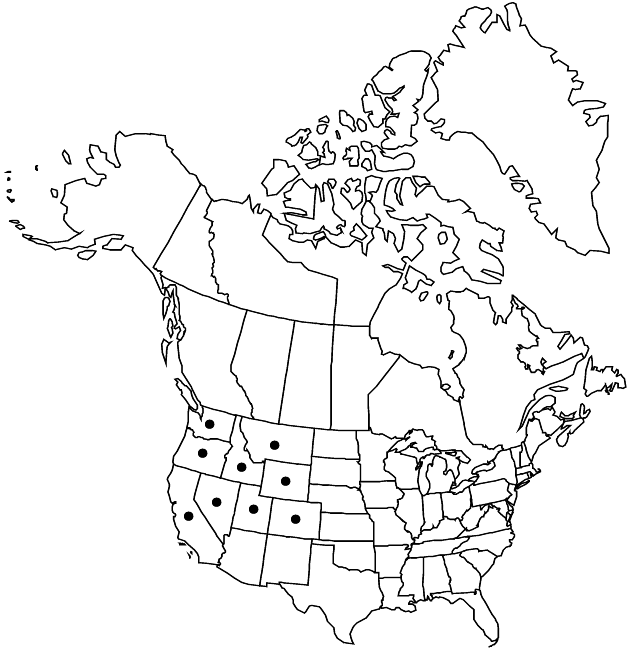Difference between revisions of "Senecio serra"
Fl. Bor.-Amer. 1: 333. 1834.
FNA>Volume Importer |
RevisionBot (talk | contribs) m (Bot: Adding category Revised Since Print) |
||
| (3 intermediate revisions by 2 users not shown) | |||
| Line 6: | Line 6: | ||
|place=1: 333. 1834 | |place=1: 333. 1834 | ||
|year=1834 | |year=1834 | ||
| + | }} | ||
| + | |special_status={{Treatment/ID/Special_status | ||
| + | |code=E | ||
| + | |label=Endemic | ||
}} | }} | ||
|basionyms= | |basionyms= | ||
| Line 19: | Line 23: | ||
-->{{Treatment/Body | -->{{Treatment/Body | ||
| − | |distribution= | + | |distribution=Calif.;Colo.;Idaho;Mont.;Nev.;Oreg.;Utah;Wash.;Wyo. |
|discussion=<p>Varieties 2 (2 in the flora).</p><!-- | |discussion=<p>Varieties 2 (2 in the flora).</p><!-- | ||
--><p>Varieties of <i>Senecio serra</i> are distinguished by head size and distribution.</p> | --><p>Varieties of <i>Senecio serra</i> are distinguished by head size and distribution.</p> | ||
| Line 50: | Line 54: | ||
|basionyms= | |basionyms= | ||
|family=Asteraceae | |family=Asteraceae | ||
| − | |distribution= | + | |distribution=Calif.;Colo.;Idaho;Mont.;Nev.;Oreg.;Utah;Wash.;Wyo. |
|reference=None | |reference=None | ||
|publication title=Fl. Bor.-Amer. | |publication title=Fl. Bor.-Amer. | ||
|publication year=1834 | |publication year=1834 | ||
| − | |special status= | + | |special status=Endemic |
| − | |source xml=https:// | + | |source xml=https://bitbucket.org/aafc-mbb/fna-data-curation/src/2e0870ddd59836b60bcf96646a41e87ea5a5943a/coarse_grained_fna_xml/V19-20-21/V20_1269.xml |
|tribe=Asteraceae tribe Senecioneae | |tribe=Asteraceae tribe Senecioneae | ||
|genus=Senecio | |genus=Senecio | ||
| Line 61: | Line 65: | ||
}}<!-- | }}<!-- | ||
| − | -->[[Category:Treatment]][[Category:Senecio]] | + | --> |
| + | |||
| + | [[Category:Treatment]] | ||
| + | [[Category:Senecio]] | ||
| + | [[Category:Revised Since Print]] | ||
Latest revision as of 18:30, 6 November 2020
Perennials, 40–100(–250) cm (caudices ligneous, branched). Herbage glabrous or lightly floccose-tomentose proximally when young. Stems single or loosely clustered. Leaves evenly distributed (proximal often withering before flowering); petiolate or subsessile; blades lanceolate or narrowly lanceolate to sublinear, 5–15(–20+) × (1–)1.5–4 cm, bases tapered, margins dentate to subentire (distal leaves smaller, bractlike). Heads 30–90+ in corymbiform to subpaniculiform arrays. Calyculi of 2–6 linear to filiform bractlets (0.5–5 mm). Phyllaries ± 8 or ca. 13, 4–9 mm, tips usually green, sometimes black. Ray florets ± 5 or ± 8; corolla laminae 5–10 mm. Cypselae glabrous or glabrate. 2n = 40.
Distribution

Calif., Colo., Idaho, Mont., Nev., Oreg., Utah, Wash., Wyo.
Discussion
Varieties 2 (2 in the flora).
Varieties of Senecio serra are distinguished by head size and distribution.
Selected References
None.
Key
| 1 | Heads 40–90+; phyllaries ± 8, 4–6 mm; ray florets ± 5, corolla laminae 5–7 mm; disc florets 10–20 | Senecio serra var. serra |
| 1 | Heads (12–)30–50; phyllaries ± 13, 7–9 mm; ray florets ± 8, corolla laminae 7–10 mm; disc florets 20–40+ | Senecio serra var. admirabilis |